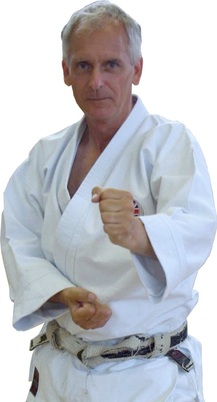The Chief Instructor of British Wadokai
After a move to Prince Rock Senior School he was also introduced to the skills of Thai-boxing (known back then as simply Kick-boxing (not to be confused with modern Kick Boxing that was introduced from America)) by one of his gym teachers.
Upon his arrival to the South of England in 1972, from Liskeard, he started Wado-ryu Karate at the age of 16 in Guildford and Bisley (Surrey), under his most influential Instructor Mick Rapley (6th Dan), in 1973 (affiliated to the United Kingdom Karate Federation (later to be known as the United Kingdom Karate-do Wadokai)). Sensei Mick Rapley was one of the earliest Wado-ka to ever obtain his Black-belt grade in this country under Tatsuo Suzuki 8th Dan Hanshi. Regular instructors at this time also included Suzuki Tatsuo Hanshi, Maeda Tadayuki Sensei, Shiomitsu Hanshi and Kobayashi Katsumi Sensei.
From this day onwards he also studied numerous other forms of Karate, as well as Shorinji-kempo, Muay-Thai, Malaysian Taekwondo (Thoi-kuen-do), Korean HoSin-sul Hapkido, various weapons systems, and a variety of other Japanese, Korean, and Chinese martial-arts.
Today he is holder of numerous titles and ranks in martial-arts including 8th Dan in Wado-ryu Karate, 2nd Dan in Korean HoSinsul Hapkido, and 1st Dan in Malaysian Taekwondo (Thoi-kuen-do).
He is the Chief Instructor to British Wadokai Karate, which has foundations that were established in 1965. British Wadokai Karate was formally the Domei Kokusai Wadokai (DKW), created in 1976, until being renamed in May 2007.
Gary Swift Kyoshi has also had the honour of training and being graded under Ohtsuka Hironori Meijin 10th Dan (founder of Wado-ryu) in 1976.
Japanese Wado instructors have included (although not linited to): Tatsuo Suzuki 8th Dan Hanshi, Katsumi Kobayashi Sensei, Masafumi Shiomitsu 9th Dan Hanshi, Yoshitsugu Shinohara 8th Dan Shihan, Tadayuki Maeda Sensei, Kuniaki Sakagami 7th Dan, Masahiro Yanagawa 8th Dan, Kengo Sugiura 8th Dan, Toru Arakawa 9th Dan, Shingo Ohgami 7th Dan, Koji Okumachi 7th Dan, Katsumi Hakoishi 8th Dan, Mizuho Ashihara 8th Dan. Other instructors have also included the famous: Tomiyama Keiji 7th Dan Shihan (Shito-ryu), Hoi Hean Thow 8th Dan (DKW-Wadoryu, Thoi-kuen-do, Tong-long, Bo-jutsu, Escrima), Dr. Julian S Lim 8th Dan (Hapkido, HoSin-sul).
His return to Plymouth, in July 2004, has allowed him to open up a new branch within British Wadokai (BWK) in Plymouth (Devon), the Plymstock Wadoryu Karate Club (Pomphlett); as the British Wadokai Honbu Dojo.
During the closing ceremony of the 2007 WadoEXL Gary was awarded the ‘prestigious’ commemorative award for the ‘Promotion and Preservation of Wadokai and Wado-ryu Karate’, an honour he will always be proud of.
Gary Swift Hanshi.
The organisation that Tatsuo Suzuki Hanshi founded in the UK was first known as the United Kingdom Karate-do Federation (UKKF), later to be known as the United Kingdom Karate-do Wadokai (UKKW). This first Wado was still guided and maintained by Ohtsuka and with the exception of the Sanbon-gumite and Ohyo Gumite, which was created by Suzuki Hanshi, was a result of Ohtsuka Meijin’s own ‘authentic’ Wado karate-do at that time.
My own Wado was a result of this direct lineage from Ohtsuka through Suzuki, and has never been influenced by any other Wado outside of the UKKW – at the time I knew of no other Wado. In 1976, during the visit from Ohtsuka Meijin to England, I trained under Ohtsuka Meijin and attempted to attend all the courses that he conducted while he was over here. Many of the techniques I learnt from him ‘first hand’ have never been changed or altered.
The concept of Nagashizuki and the many implications of the Kihon-gumite have been ingrained into me from that visit. My 4th Kyu grading was also conducted by Ohtsuka Meijin, and I am privileged and honoured to have his signature still on my UKKF licence from that day.
In 1982 Ohtsuka Meijin passed away, and left behind a great legacy for all of us to follow. However, following his passing, there was split after split within the Wado fraternity and Wado took on many different directions.
Soon after this, Wado had another big split, this time with the parting of Suzuki Hanshi (and other Japanese Instructors) from what was then, and now, the Wado Renmei.
In British Wadokai we still train with the original syllabus, which also includes the Sanbon-gumite, which are very much misunderstood today; and in many Wado schools they have even been removed completely, which is such a shame as they can reflect so much of the Ju-Jutsu aspects and principles within them (continual contact, distancing, entering, etc.).
The Ohyo-gumite, which encourages principles of free-fighting; another very important aspect of all Wado. Again, these are often misunderstood and have been taken out by many Wado Schools. However, saying this, some schools have replaced the original Ohyo-gumite with some more competition orientated versions, which may also reflect some of these similar concepts within them.
I have been very privileged and lucky and have learnt much from the many Japanese Wado Instructors throughout my time, and because of this I have added to the training many aspects over the years, such as Tanto-dori, Idori, Muto-dori, etc.
British Wadokai is what it is, ‘British’ Wadokai – no more, no less; this is from where the Wado of today has evolved.
“Making our students better than ourselves.” Gary E Swift Hanshi.











